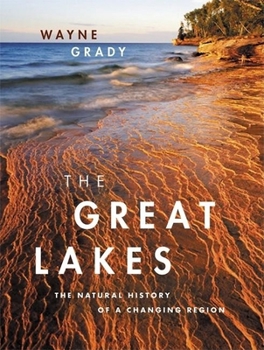The Great Lakes: The Natural History of a Changing Region
Select Format
Select Condition 
Book Overview
Five immense lakes lie at the heart of North America. They cover an area of nearly 95,000 square miles and hold more than 5,500 cubic miles of water. Together they comprise the world's largest... This description may be from another edition of this product.
Format:Hardcover
Language:English
ISBN:1553651979
ISBN13:9781553651970
Release Date:October 2007
Publisher:Greystone Books
Length:320 Pages
Weight:2.56 lbs.
Dimensions:1.1" x 7.5" x 10.0"
Customer Reviews
3 ratings
Great Lakes History
Published by Thriftbooks.com User , 15 years ago
This book is just outstanding. If you love the Great Lakes region, you must read this book.
Encyclopedic but engaging
Published by Thriftbooks.com User , 16 years ago
Noted Canadian author, Wayne Grady, has given the Great Lakes community a wonderful gift with his book The Great Lakes: The Natural History of a Changing Region.This is a very comprehesive book covering the geology, ecology, and history of the region, as well as the challenges it faces in the future. After introductory chapters on the history and geology of the Great Lakes, Grady spends the core of the book looking at three ecological zones that characterize the region. The boreal forest of the north, the central Great Lakes-St. Lawrence forest, and the Carolinian forest that typifies the southern Great Lakes region. In one chapter he discusses the unique landscapes of wetlands and dunes, and in another the aquatic ecology of the lakes themselves. He wraps up the book with a look at the impact of invasive species and the challenges facing the Great Lakes in the future. The scope of the book is rather encyclopedic, and at times it does read a bit like an ecyclopedia. But just when your feeling a bit overwhelmed by the scope of Grady's knowledge, he tantalizes you with a fact that is so intriguing that you really want to keep reading to discover more. For example, did you know that the beaver is the only mammal whose growth is indeterminate? They just keep growing! The book is nicely illustrated, primarily with the wonderful photographs of Bruce Litteljohn. To be honest, I would have welcomed a more lavish presentation of this fine photography. The Great Lakes: The Natural History of a Changing Region is a serious and substantive work that manages to also be entertaining and engaging. I don't think you could ask much more of any book.
Another book on the Great Lakes?
Published by Thriftbooks.com User , 16 years ago
Quite so. That's a good thing, given that this one is written by one of Canada's pre-eminent science nature writers. Grady caps a long career in depicting our understanding of Nature's phenomena with this examination of the string running over part of the Canadian-US border. Containing nearly a fifth of the world's supply of fresh water, the lakes are important to vast lands and populations in North America. Grady points out that many misconceptions about the Lakes abound. Change is endemic in the Lake system, and artificial change must be considered with the utmost care, based on careful analysis. His flowing prose, enhanced by lavish maps, photographs and illustrations, imparts the view of the lakes as a dynamic system. The book's subtitle "the Natural History of A Changing Region" sets the theme. Resulting from the scouring of the Laurentide Glacier as it retreated ten thousand years ago, the Lakes exhibit individual profiles and behaviours. The final outlines of the Lakes emerged about the time Egypt began constructing the Pyramids. A view of "The Water World" explains how lake water "turns over" according to the season, and how the varying depths influence the flow and the life in and around them. Which Lake is deepest may not be a surprise, but the second deepest and shallowest may reveal misconceptions. Lake Superior holds more water than the others combined, and is the fourth largest in the world. Delimiting the outlines is only the beginning for Grady, who takes us through the entire ecological framework of the region. We are shown the forest types around the Lakes, the wetlands of the their margins, and the river systems feeding them. The forests are divided into three zones, Boreal, Great Lakes-St Lawrence and Carolinian. Each is populated with various proportions of tree types, bird, animal and fish life. The planet's longest surviving species of bird, the Sandhill Crane resides here - and has for 10 million years. The oldest known tracks of an animal, a euthycarcinoid strode along some Ontario sand nearly 500 million years ago. The soils are of one kind here, another there. All the description is wrapped in a picture of shifting conditions. The dynamics of the Lake environments are the key to our understanding their past, present and future. What we see today isn't just "there" - it has all derived from past times and environments. Although the Lakes' shorelines aren't densely inhabited, the demand for their waters comes from adjacent and distant regions alike. It has been estimated that 95 per cent of North America's fresh water derives from the Great Lakes. Will it always be available? Recent studies show the levels are dropping - some shipping must empty ballast or off-load cargo to sustain passage in some seasons and locales. The US Army Corps of Engineers has already shifted drainage patterns over the years, with more proposed. The Bourassa government of Quebec attempted a plan to dam James Bay,






